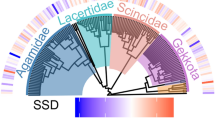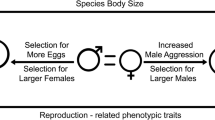Abstract
Rensch’s rule refers to a pattern in sexual size dimorphism (SSD) in which SSD increases with body size when males are the larger sex and decreases with body size when females are the larger sex. Using data on body size from 40 populations and age from 31 populations of the rice frog Rana limnochari with female-biased size dimorphism, I tested the consistency of allometric relationships between males and females with Rensch’s rule and evaluated the hypothesis that SSD was largely a function of age differences between the sexes. Statistical comparisons of body sizes between the sexes showed the evidence for the inverse of Rensch’s rule, indicating the level of SSD increased with increasing mean body size. One of the explanations for the occurrence of the inverse of Rensch’s rule may be the fecundity selection hypothesis assuming increased reproductive output in large females. However, differences in age between males and females among populations could explain mildly the variation in SSD.



Similar content being viewed by others
References
Abouheif, E., & Fairbairn, D. J. (1997). A comparative analysis of allometry for sexual size dimorphism: Assessing Rensch’s rule. American Naturalist, 149, 540–562.
Andersson, M. (1994). Sexual selection. Princeton: Princeton University Press.
Berven, K. A. (1982). The genetic basis of altitudinal variation in the wood frog Rana sylvatica. An experimental analysis of life history traits. Evolution, 36, 962–983.
Blanckenhorn, W. U. (2000). The evolution of body size: What keeps organisms small? Quarterly Review of Biology, 75, 385–407.
Blanckenhorn, W. U. (2005). Behavioural causes and consequences of sexual size dimorphism. Ethology, 111, 977–1016.
Boucher, S., Crete, M., Ouellet, J. P., Daigle, C., & Lesage, L. (2004). Large-scale trophic interactions: White-tailed deer growth and forest understory. Ecoscience, 11, 286–295.
Castanet, J., & Cheylan, M. (1979). Les marques de croissance des os et des écailles comme indicateur de l’âge chez Testudo hermanni et Testudo graeca (Reptilia, Chelonia, Testudinidae). Canadian Journal of Zoology, 57, 1649–1665.
Colwell, R. K. (2000). Rensch’s rule crosses the line: Convergent allometry of sexual size dimorphism in hummingbirds and flower mites. American Naturalist, 156, 495–510.
Cox, R. M., Kelly, S. L., & John-Adler, H. B. (2003). A comparative test of adaptive hypotheses for sexual size dimorphism in lizards. Evolution, 57, 1653–1669.
Dale, J., Dunn, P. O., Figuerola, J., Lislevand, T., Székely, T., & Whittingham, L. A. (2007). Sexual selection explains Rensch’s rule of allometry for sexual size dimorphism. Proceeding of Royal Society London B, 274, 2971–2979.
Fairbairn, D. J. (1997). Allometry for sexual size dimorphism: Pattern and process in the coevolution of body size in males and females. Annul Review Ecology and Systematics, 28, 659–687.
Fairbairn, D., Blanckenhorn, W., & Székely, T. (2007). Sex, size and gender roles. Evolutionary studies of sexual size dimorphism. Oxford: Oxford University Press.
Hemelaar, A. S. M. (1981). Age distribution of male Bufo bufo (Amphibia: Anura) from the Netherlands, based on year rings in phalanges. Amphib-Reptilia, 1, 223–233.
Herczeg, G., Gonda, A., & Merilä, J. (2010). Rensch’s rule inverted—female-driven gigantismin nine-spined stickleback Pungitius pungitius. Journal of Animal Ecology, 79, 581–588.
Lengkeek, W., Didderen, K., Cote, I. M., van der Zee, E. M., Snook, R. C., & Reynolds, J. D. (2008). Plasticity in sexual size dimorphism and Rensch’s rule in mediterranean blennies (Blenniidae). Canadian Journal of Zoology, 86, 1173–1178.
Li, Y. M., Xu, F., Guo, Z. W., Liu, X., Jin, C. N., Wang, Y. P., et al. (2011). Reduced predator species richness drives the body gigantism of a frog species on the Zhoushan Archipelago in China. Journal of Animal Ecology, 80, 171–172.
Liao, W. B. (2011). A skeletochronlogical estimate of age in a population of the Siberian Wood Frog, Rana amurensis, from northeastern China. Acta Herpetological, 6, 237–245.
Liao, W. B., & Chen, W. (2012). Inverse Rensch-rule in a frog with female-biased sexual size dimorphism. Naturwissenschaften, 99, 427–431.
Liao, W. B., & Lu, X. (2010a). Age structure and body size of the Chuanxi tree frog Hyla annectans chuanxiensis from two different elevations in Sichuan (China). Zoologischer Anzeiger, 248, 255–263.
Liao, W. B., & Lu, X. (2010b). A skeletochronlogical estimation of age and body size by the Sichuan torrent frog (Amolops mantzorum) between two populations at different altitudes. Animal Biology, 60, 479–489.
Liao, W. B., & Lu, X. (2011). Variation in body size, age and growth in the Omei Treefrog (Rhacophorus omeimontis) along an altitudinal gradient in western China. Ethology Ecology and Evolution, 23, 248–261.
Liao, W. B., & Lu, X. (2012). Adult body size = f (initial size + growth rate × age): Explaining the proximate cause of Bergman’s cline in a toad along altitudinal gradients. Evolutionary Ecology, 26, 579–590.
Liao, W. B., Lu, X., Shen, Y. W., & Hu, J. C. (2011). Age structure and body size of two populations of the rice frog Rana limnocharis from different altitudes. Italian Journal of Zoology, 78, 215–228.
Liao, W. B., Zhou, C. Q., Yang, Z. S., Hu, J. C., & Lu, X. (2010). Age, size and growth in two populations of the dark-spotted frog Rana nigromaculata at different altitudes in southwestern China. Herpetological Journal, 20, 77–86.
Liu, Y. H., Liao, W. B., Zhou, C. Q., & Mi, Z. P. (2012). Altitudinal variation in body size in the Rice Frog (Rana limnocharis) in southwestern China. Acta Herpetological, 7, 57–68.
Lou, S. L., Jin, L., Liu, Y. H., Mi, Z. P., Tao, G., Tang, Y. M., et al. (2012). Altitudinal variation in age and body size in Yunnan Pond Frog (Pelophylax pleuraden). Zoological Science, 29, 493–498.
Monnet, J. M., & Cherry, M. I. (2002). Sexual size dimorphism in anurans. Proceeding of Royal Society London B, 269, 2301–2307.
Polák, J., & Frynta, D. (2009). Sexual size dimorphism in domestic goats, sheep, and their wild relatives. Biological Journal of Linnean Society, 98, 872–883.
Polák, J., & Frynta, D. (2010). Patterns of sexual size dimorphism in cattle breeds support Rensch’s rule. Evolutionary Ecology, 24, 1255–1266.
Remeš, V., & Székely, T. (2010). Domestic chickens defy Rensch’s rule: Sexual size dimorphism in chicken breeds. Journal of Evolutionary Biology, 23, 2754–2759.
Rensch, B. (1960). Evolution above the species level. New York: Columbia University Press.
Shi, L. Q., Zhang, X. Q., & Ma, X. M. (2011). Ontogeny in sexual dimorphism and female reproduction of rice frog Fejervarya limnocharis. Chinese Journal of Ecology, 30, 717–723.
Shine, R. (1979). Sexual selection and sexual dimorphism in the amphibia. Copeia, 1979, 297–306.
Shou, H. L., Du, W. G., & Shu, L. (2005). Sexual dimorphism and fecundity in the gold-stripe pond frog (Pelophylax plancyi) and the terrestrial frog (Fejervarya limnocharis). Acta Ecological Sinca, 25, 664–668.
Smith, R. J. (1999). Statistics of sexual size dimorphism. Journal of Human Evolution, 36, 423–459.
Smith, R. J., & Cheverud, J. M. (2002). Scaling of sexual dimorphism in body mass: A phylogenetic analysis of Rensch’s rule in primates. International Journal of Primatology, 23, 1095–1135.
Sokal, R. R., & Rohlf, F. J. (1981). Biometry: The principles and practice of statistics in biological research. Freeman, WH. San Francisco.
Starostová, Z., Kubička, L., & Kratochvíl, L. (2010). Macroevolutionary pattern of sexual size dimorphism in geckos corresponds to intraspecific temperature-induced variation. Journal of Evolutionary Biology, 23, 670–677.
Stephens, P. R., & Wiens, J. J. (2009). Evolution of sexual size dimorphisms in Emydid turtles: Ecological dimorphism, Rensch’s rule, and sympatric divergence. Evolution, 63, 910–925.
Stuart-Fox, D. (2009). A test of Rensch’s rule in dwarf chameleons (Bradypodion spp.), a group with female-biased sexual size dimorphism. Evolutionary Ecology, 23, 425–433.
Székely, T., Freckleton, R. B., & Reynolds, J. D. (2004). Sexual selection explains Rensch’s rule of size dimorphism in shorebirds. Proceedings of the National Academy of Sciences, 101, 12224–12227.
Tubaro, P. L., & Bertelli, S. (2003). Female-biased sexual size dimorphism in tinamous: A comparative test fails to support Rensch’s rule. Biological Journal of the Linnean Society, 80, 519–527.
Webb, T. J., & Freckleton, R. P. (2007). Only half right: Species with female-biased sexual size dimorphism consistently break Rensch’s rule. PLoS ONE, 2, e897.
West, S. (2009). Sex allocation. Princeton, NJ: Princeton University Press.
Wu, Z. J., Li, Y. M., & Murray, B. (2006). Insular shifts in body size of rice frogs in the Zhoushan Archipelago. Journal of Animal Ecology, 75, 1071–1080.
Xiong, H. L., Liu, Y., Qin, L. J., & Xiong, Z. B. (2010). Breeding ecology of Fejervarya multistriata in Maolan Region. Sichuan Journal of Zoology, 29, 353–359.
Zamudio, K. R. (1998). The evolution of female-biased sexual size dimorphism: A population-level comparative study in horned lizards (Phrynosoma). Evolution, 52, 1821–1833.
Zhang, L. X., & Lu, X. (2012). Sexual size dimorphism in anurans: ontogenetic determination revealed by an across-species comparison. Evolutionary Biology. doi:10.1007/s11692-012-9187-2.
Acknowledgments
I thank Sang Lin Lou, Long Jin, Yu Mei Tang, Gang Tao, Yan Hong Lou and Wen Cao Liu for assistance during the field and lab work. I also thank two anonymous reviewers for critical comments on an earlier draft of this manuscript. Financial support was provided by the National Natural Sciences Foundation of China (31101633) and Innovative Team Foundation of China West Normal University.
Author information
Authors and Affiliations
Corresponding author
Rights and permissions
About this article
Cite this article
Liao, W.B. Evolution of Sexual Size Dimorphism in a Frog Obeys the Inverse of Rensch’s Rule. Evol Biol 40, 293–299 (2013). https://doi.org/10.1007/s11692-012-9212-5
Received:
Accepted:
Published:
Issue Date:
DOI: https://doi.org/10.1007/s11692-012-9212-5




